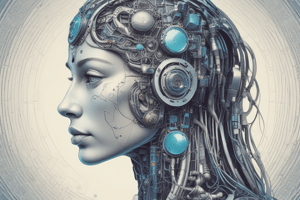Podcast
Questions and Answers
What type of AI-powered design tools generate logo designs based on user input?
What type of AI-powered design tools generate logo designs based on user input?
- Design assistance tools
- Logo generation tools (correct)
- AI-generated design assets
- Typography suggestion tools
Which of the following is an example of an AI-generated design asset?
Which of the following is an example of an AI-generated design asset?
- Logojoy
- Wix Logo Maker
- Adobe Fresco
- Deep Dream Generator (correct)
What is a key design principle for AI software logos in terms of scalability?
What is a key design principle for AI software logos in terms of scalability?
- Flexibility and adaptability
- Simpllicity and scalability (correct)
- Uniqueness and memorability
- Consistency and cohesion
Which of the following design principles for AI software logos is related to aligning with the brand's overall visual identity?
Which of the following design principles for AI software logos is related to aligning with the brand's overall visual identity?
What is the primary goal of AI-powered design tools?
What is the primary goal of AI-powered design tools?
Which design principle for AI software logos is related to conveying the brand's message and values?
Which design principle for AI software logos is related to conveying the brand's message and values?
Flashcards are hidden until you start studying
Study Notes
AI-powered Design Tools
- Logo generation tools:
- Use AI algorithms to generate logo designs based on user input (e.g., brand name, industry, color scheme)
- Examples: Logojoy, Tailor Brands, Wix Logo Maker
- Design assistance tools:
- Utilize AI to assist in the design process, such as suggesting layouts, colors, and typography
- Examples: Adobe Fresco, Sketch, Figma
- AI-generated design assets:
- Create custom design assets, such as icons, graphics, and patterns, using AI algorithms
- Examples: Deep Dream Generator, Prisma, AI Painter
Design Principles for AI Software Logos
- Simpllicity and scalability:
- AI software logos should be simple, yet distinctive, to ensure scalability across various platforms and resolutions
- Consistency and cohesion:
- Logos should align with the brand's overall visual identity and messaging
- Flexibility and adaptability:
- AI software logos should be adaptable to different contexts, such as light and dark modes, and various color schemes
- Uniqueness and memorability:
- AI software logos should be distinctive and memorable, avoiding clichés and common design elements
- Storytelling and meaning:
- AI software logos should convey the brand's message, values, and purpose through clever design and symbolism
AI-powered Design Tools
- AI algorithms are used to generate logo designs based on user input, including brand name, industry, and color scheme.
- Logojoy, Tailor Brands, and Wix Logo Maker are examples of logo generation tools.
- AI-powered design assistance tools suggest layouts, colors, and typography to aid in the design process.
- Adobe Fresco, Sketch, and Figma are examples of design assistance tools.
- AI-generated design assets, such as icons, graphics, and patterns, can be created using AI algorithms.
- Deep Dream Generator, Prisma, and AI Painter are examples of AI-generated design assets.
Design Principles for AI Software Logos
Simplicity and Scalability
- AI software logos should be simple and distinctive to ensure scalability across various platforms and resolutions.
Consistency and Cohesion
- AI software logos should align with the brand's overall visual identity and messaging.
Flexibility and Adaptability
- AI software logos should be adaptable to different contexts, such as light and dark modes, and various color schemes.
Uniqueness and Memorability
- AI software logos should be distinctive and memorable, avoiding clichés and common design elements.
Storytelling and Meaning
- AI software logos should convey the brand's message, values, and purpose through clever design and symbolism.
Studying That Suits You
Use AI to generate personalized quizzes and flashcards to suit your learning preferences.




